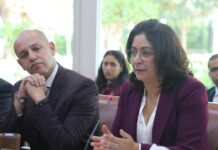Over the 2023-2024 academic year, Morocco witnessed continued growth in preschool enrollment rates for children aged 4 to 5. Nationally, the rate reached 62.7%, with significant differences between urban and rural areas. In cities, preschool attendance stood at 66.8%, while rural regions lagged behind at 56.9%. Gender parity remains close, with 62.5% of boys and 63% of girls attending preschool.
For children aged 6 to 11, primary school enrollment has also seen steady improvement over the past decade. Between 2014 and 2024, the national rate increased from 94.5% to 95.8%. The progress is particularly striking in rural areas, where enrollment rose from 91.4% to 95.1%. Among girls, the rate improved significantly from 93.9% to 95.9%, with rural girls making exceptional strides, increasing from 90% to 95.1% over the same period.
Morocco’s secondary education enrollment for children aged 12 to 14 has also improved markedly. Nationally, the rate climbed from 84.1% in 2014 to 92.8% in 2024. This upward trend is more prominent in rural areas, where the rate surged from 72.3% to 87.9%. In urban areas, the rate rose more moderately from 93.4% to 96.1%. The gender gap, once significant, has largely closed. In 2014, boys recorded an enrollment rate of 88.7% compared to 79.4% for girls. By 2024, the figures nearly equalized, with boys at 93.4% and girls at 92.1%.
The average number of years of education for Moroccans aged 25 and older has also improved substantially over the past decade. In 2014, the average stood at 4.4 years; by 2024, it had risen to 6.3 years. However, disparities remain between urban and rural populations. In cities, the average is 7.9 years, whereas in rural areas, it is only 3.2 years. Gender differences are also apparent, with men averaging 7.3 years of education compared to 5.2 years for women.
Regionally, the average years of schooling vary widely. The regions of Laayoune-Sakia El Hamra, Casablanca-Settat, Dakhla-Oued Ed-Dahab, and Rabat-Salé-Kenitra stand out with averages exceeding the national rate. Laayoune-Sakia El Hamra leads with 7.9 years, followed by Casablanca-Settat with 7.5 years. In contrast, regions such as Béni Mellal-Khénifra, Drâa-Tafilalt, and Marrakech-Safi record the lowest averages, ranging between 4.9 and 5.3 years.
The educational attainment of the population aged 25 and older has also improved significantly. In 2014, only 30.2% of the population had reached at least lower secondary education. By 2024, this proportion increased to 39.1%. Over the same period, the share of the population without any formal education dropped from 44.6% to 36.3%. However, the proportion of individuals with only primary-level education has remained stagnant, hovering around 21%.
The improvement in educational attainment highlights a clear divide between urban and rural areas, as well as between men and women. In urban areas, more than half of the population aged 25 and older, at 50.4%, has achieved at least lower secondary education. In rural areas, the proportion is significantly lower at 18.1%. Similarly, 45.7% of men reached this level compared to 32.7% of women.
Regional variations in educational attainment reflect similar trends. Regions such as Laayoune-Sakia El Hamra, Dakhla-Oued Ed-Dahab, Casablanca-Settat, and Rabat-Salé-Kenitra record the highest proportions of individuals with at least lower secondary education, surpassing the national average. Laayoune-Sakia El Hamra tops the list with 50.3%, while regions such as Marrakech-Safi, Souss-Massa, Drâa-Tafilalt, and Béni Mellal-Khénifra show much lower rates, hovering around 31% to 33%.
Illiteracy rates have also dropped significantly across the country. In 2024, the overall illiteracy rate stood at 24.8%, compared to 32.2% a decade earlier. The decline is more notable in rural areas, where the rate decreased from 47.5% to 38%. In urban areas, it fell from 22.6% to 17.3%. Women experienced a sharper reduction in illiteracy, with rates falling from 42.1% to 32.4%, compared to a decrease from 22.2% to 17.2% for men.
Age remains a significant factor in illiteracy levels. Among those under the age of 15, the rate is remarkably low at 1.6%, while it climbs to 3% for individuals aged 15 to 24. However, among those aged 50 and older, illiteracy remains high at 51%. These figures represent a significant improvement over 2014, when rates stood at 3.9% for the youngest age group, 11% for those aged 15 to 24, and a concerning 61.4% for the older population.
At the regional level, illiteracy remains most prevalent in areas such as Béni Mellal-Khénifra, Marrakech-Safi, the Oriental, and Drâa-Tafilalt, where rates exceed 28%. In contrast, regions such as Dakhla-Oued Ed-Dahab, Laayoune-Sakia El Hamra, and Casablanca-Settat record the lowest rates, ranging between 14.8% and 19.6%.
The progress made over the past decade reflects Morocco’s sustained efforts to improve access to education, reduce gender and regional disparities, and tackle illiteracy. However, the data also highlights persistent gaps that require continued investment and policy focus, particularly in rural areas and among women.





